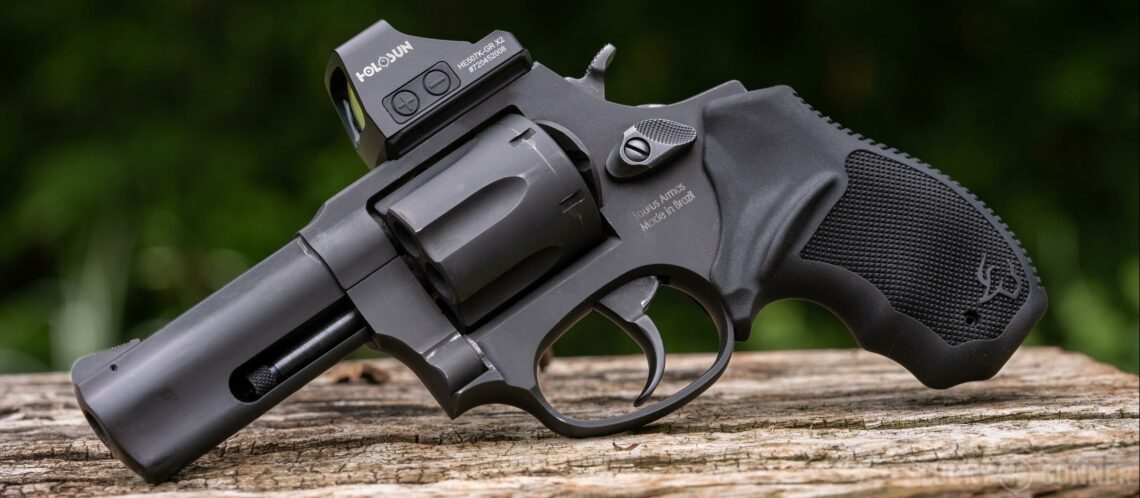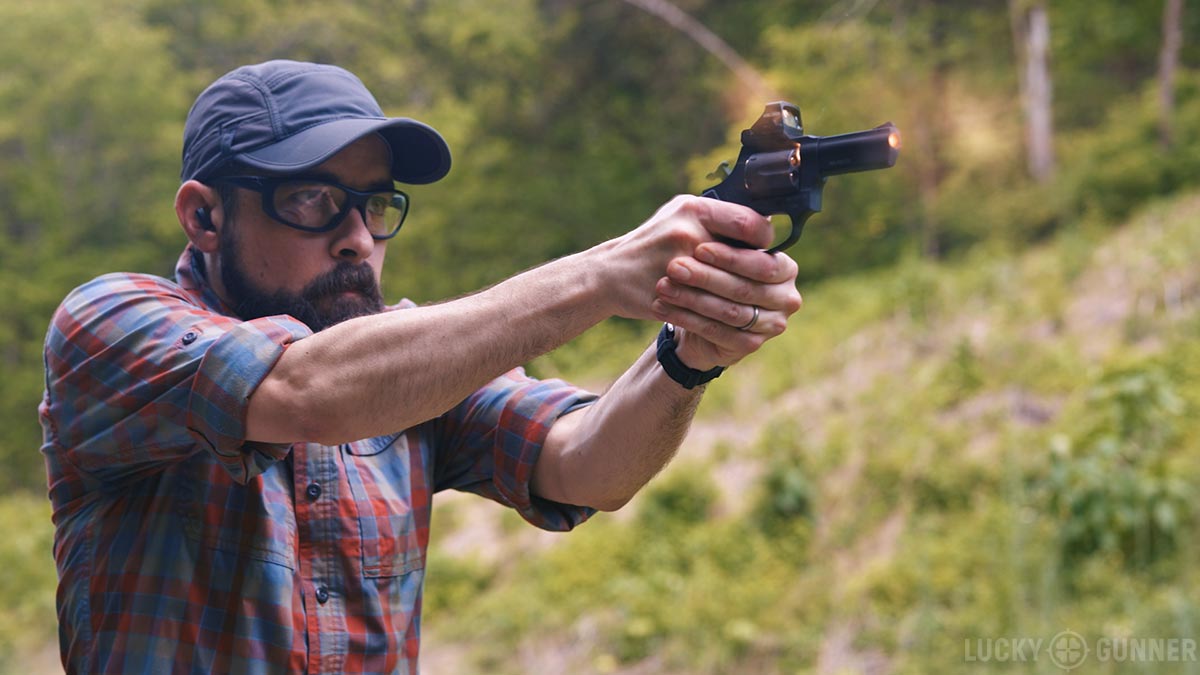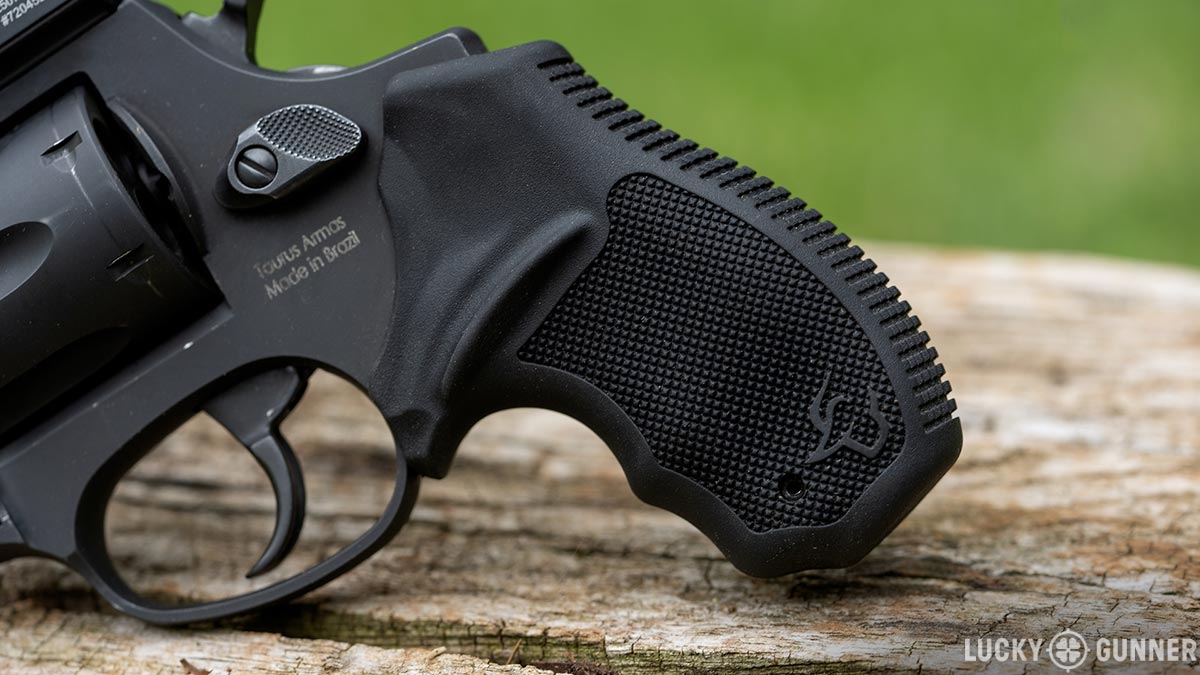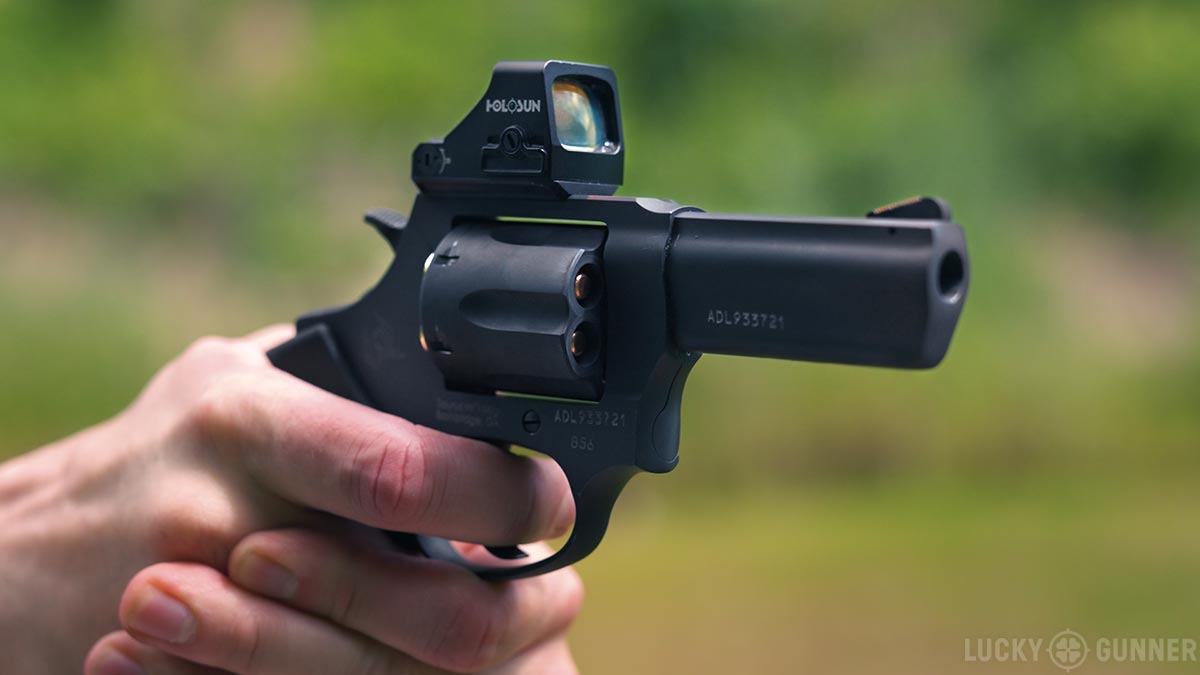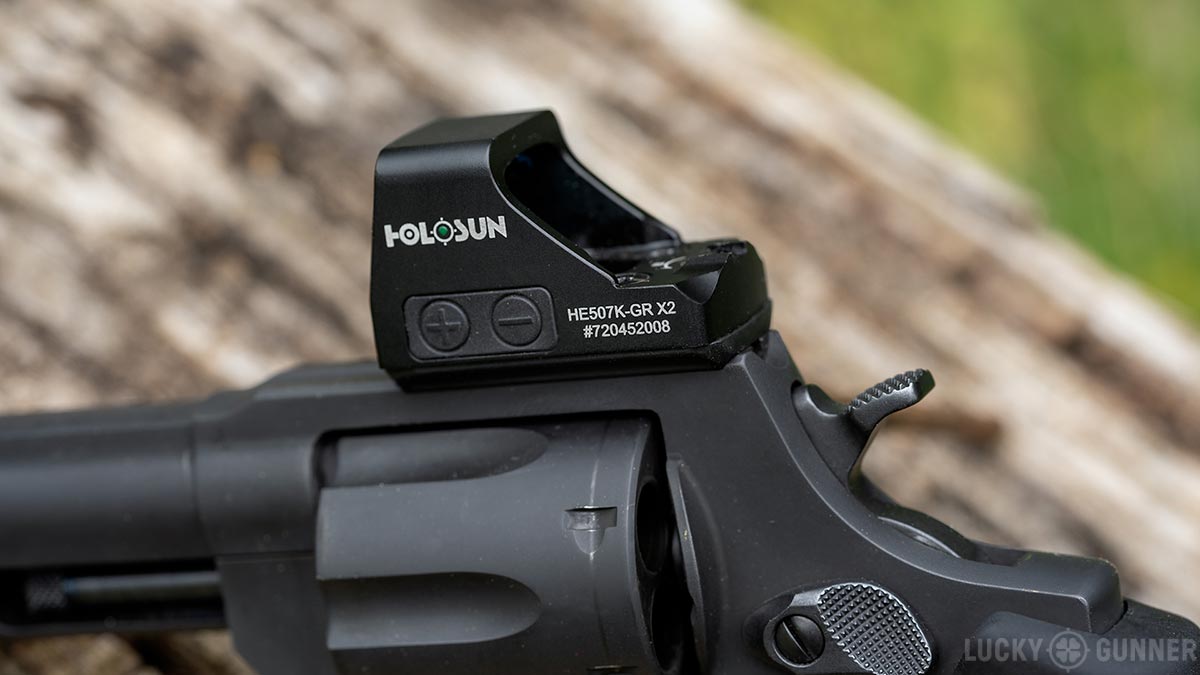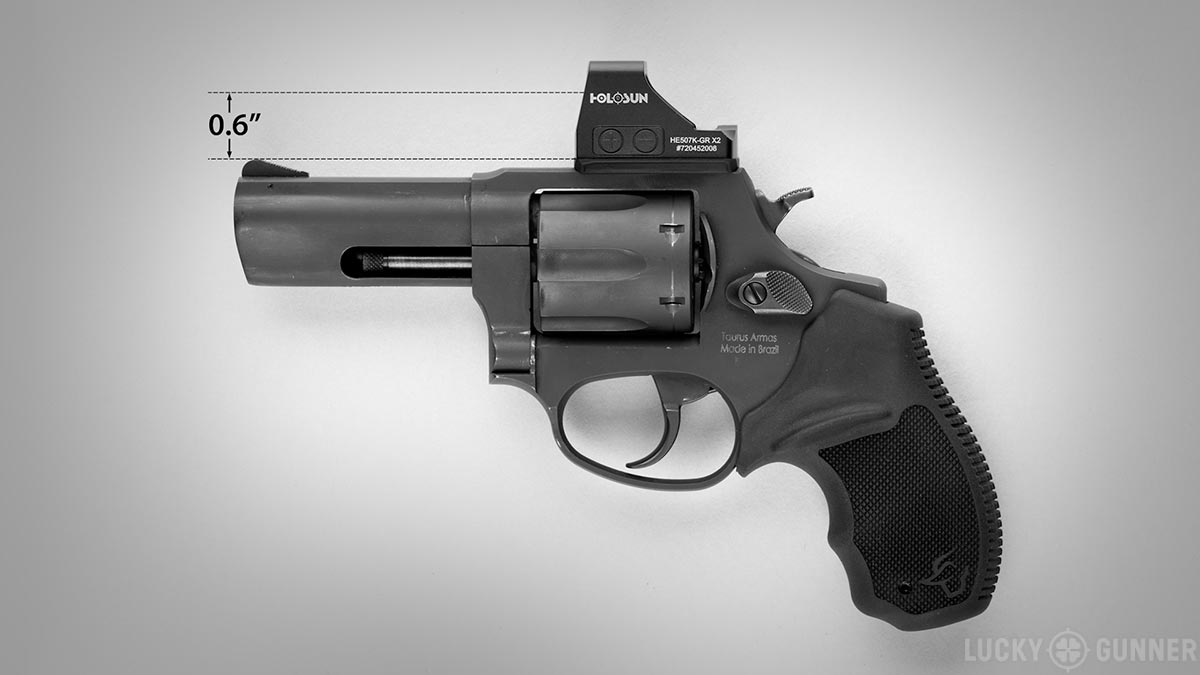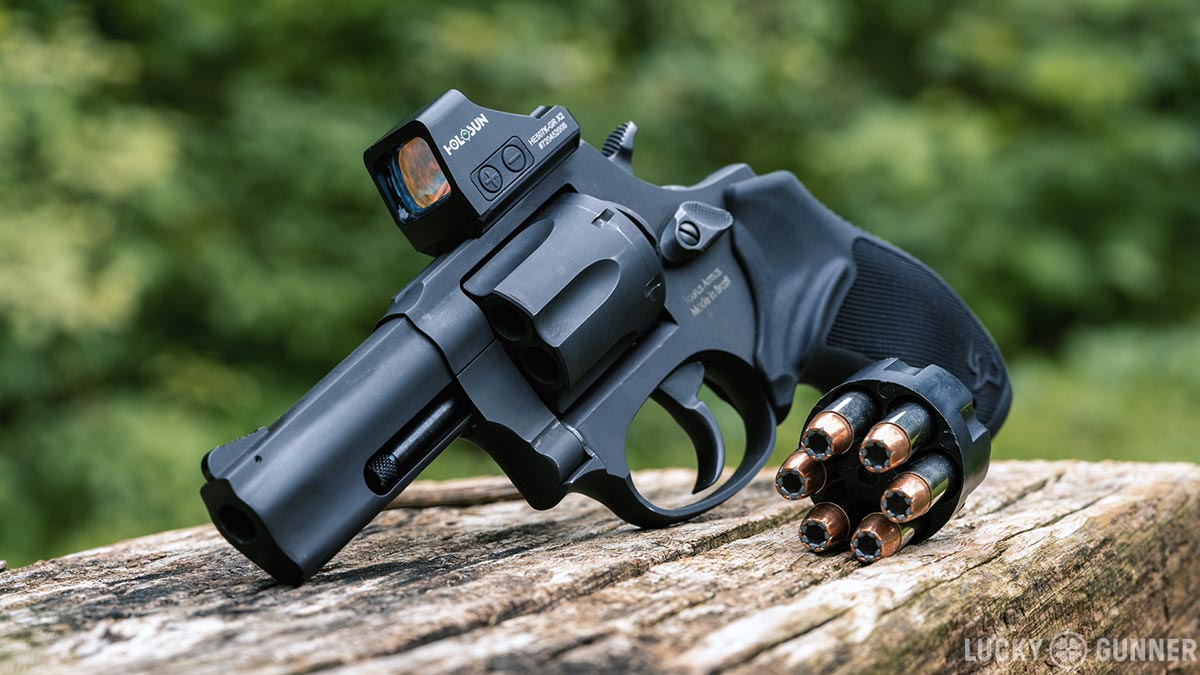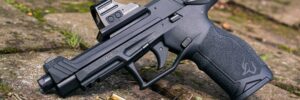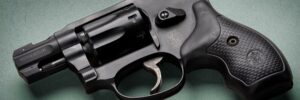This review should not exist. I’ve been an outspoken fan of small, lightweight carry revolvers. The 856 TORO is anything but lightweight.
And it’s a Taurus — until recently, a brand name that I have, for the most part, politely ignored.
But today’s Taurus is not the Taurus of five years ago. And it’s been at least five years since the other big-name revolver companies have released anything innovative and/or interesting. So that leaves room for the new and improved Taurus to be the first to make a small carry revolver that comes optics-ready from the factory. And that’s an idea worth investigating.
Details are in the video below, or scroll down to read the full transcript.
Taurus 856 TORO
Hey everybody, I am Chris Baker from LuckyGunner.com. Today we’re going to take a look at the Taurus 856 TORO – an optics-ready carry revolver.
The 856 series has been around for a few years. They are small-frame 6-shot revolvers chambered for .38 Special +P. It’s roughly the same size as a Ruger SP-101, but with an extra round in the cylinder. Taurus makes several variants of the 856 with different barrel lengths, finishes, and steel or lightweight aluminum frames.
Among those variants is the 856 Defender, which is what they call the models with 3-inch barrels. Earlier this year, Taurus took the steel version of the Defender, added an optic plate, drilled a couple of corresponding mounting holes in the top strap and launched it as the 856 TORO – Taurus Optic Ready Option. At the same time, they released the 605 TORO, which is essentially the same gun, but it’s chambered for .357 Magnum with a five shot capacity. Together, these are the very first small-frame revolvers to come optics-ready from the factory.
I don’t review every new gun that comes along. Usually no more than two or three per year. But this one caught my attention, and Taurus generously obliged my request to borrow a review sample.
Why Taurus?
A couple of years ago, I probably would have ignored the 856 TORO because – well, it’s a Taurus. I talked about this a little bit when I reviewed the Taurus TX-22 Competition last year. Taurus has developed a questionable reputation and my personal experience has only confirmed that reputation.
But there have been some changes at Taurus. They’re under new leadership. They’ve invested heavily in new equipment and personnel. They have new processes and standards for pretty much everything from the product design phase to quality control.
That all sounds like the kind of thing we would want to hear. Of course, this single revolver can’t tell us whether Taurus has truly made a 180. But I will share my impressions so far and whether it looks like a step in the right direction. After that, I’ll dive into this crazy idea of sticking an optic on a carry revolver.
The Basics
Without the optic mount, the 856 TORO is a very basic, affordable 3-inch small frame .38. Not that there’s anything wrong with that. There’s definitely a place for simple and affordable, especially when so much of the revolver market is focused on overpriced flashy nostalgia.
But history has shown us that it’s deceptively difficult to mass-produce a revolver that is both affordable and reliable. Sacrifices have to be made somewhere.
For example, the matte black finish on this 856 TORO is somewhat delicate. It’s got a couple of sharp edges and corners that you would not find on a more expensive model. And the trigger is just “okay.” It’s similar to a Smith J-frame trigger. It improves a lot with dry practice and it’s good enough, but still on the heavy side.
Speaking of heavy, this is not a lightweight gun. Unloaded with no optic, it weighs 23.8 ounces. The optic plate, optic, and ammo add just over 4 ounces for a total of 28.2 loaded. That’s comparable to an SP-101 or a Kimber K6S. So it’s not as convenient to carry as an Airweight J-frame or an LCR, but it is a lot more comfortable to shoot.
Taurus 856 TORO Features and Accessories
There are a few well thought-out features here that you don’t always find on small-frame revolvers. It’s got a full-length ejector rod – most companies just use the same stumpy ejector rod from their 2-inch models. The hammer spur is short with rounded corners. I personally prefer no hammer spur at all, but if you’re going to have one, this is the way to do it for a carry revolver.
In addition to the optic plate, the TORO does have the same iron sights as the rest of the 856 series. There’s a trench style fixed rear sight notch, which I’m not wild about, but that’s pretty typical. However, the serrated ramp front sight is not machined into the barrel like a lot of small revolvers. It’s a pinned sight, so you can swap it out for an aftermarket option like a high-visibility night sight from XS or Ameriglo.
Revolver grip preference is a highly individual factor. There’s no way to make a grip that fits everyone, and sometimes they fit no one. Overall, this grip is not bad. It’s very short, which is ideal for a carry revolver. The rubber material is good for cushioning recoil. I would prefer it to be a little thicker from front to back – it doesn’t fill my hand as well as I’d like. But I say that about most revolver grips.
I tried a few of the aftermarket options, of which there are a plethora. I liked the VZ model 320 grips the best. Those are a little longer than the factory grips and I think I lost more in terms of concealability than I gained in shootability. So I’m back to the factory grips.
Carrying a reload for your revolver is the epitome of optimism. But I like to have a few speedloaders to use at the range. A lot of the Colt D-Frame or Smith & Wesson K-frame loaders will work with the Taurus 856. As always, you’ve got the twisty-knob style loaders from HKS, Pachmayer, and 5-Star. I got the K-frame version of the Safariland Comp II loaders to work with a minor hiccup here and there. The longer loaders like the Comp III can be pretty hit or miss because there’s so little clearance between the cylinder and the frame.
With an optic installed, the 856 TORO will not fit in most holsters made for the standard 856. You can try a DIY solution and attempt your own optic cut, or you can get a holster specifically designed around the optic. There are options on the way from a couple of my favorite holster makers. This is a pre-production sample of the Apollo holster from Dark Star Gear – it fits the gun with or without an optic installed. PHLster Holsters also has one that should be released any day now.
But Does it Work?
Okay, so how about reliability? Does this gun work? I’ve got about 800 rounds through this one with no complaints so far. Just like any revolver, it is maintenance-sensitive. I start to feel the action get a little sluggish if I don’t brush out under the extractor star after every couple hundred rounds or so. The only actual failures I experienced were some light primer strikes after I tried to lighten the trigger with a reduced power hammer spring from Galloway Precision. But I can hardly fault the gun for that. By the way, I also tried a hammer spring from Wolff that’s heavier than the Galloway but lighter than the original and it works just fine.
Overall, this has been a much better experience than I would have expected from a Taurus a couple of years ago. And honestly, it’s worked better than a lot of revolvers from other big-name companies that I’ve tried in recent years. I’m not saying Taurus is “just as good as”… fill in the blank with your favorite revolver brand. I do think they’re worth a second look.
The Weird World of Revolver Optics
So that brings us to the other elephant in the room – the optic. Optics on revolvers are weird. It’s an awkward combination of old and new that seems to make a lot of people uncomfortable. But here at Lucky Gunner, we like to embrace the awkwardness. So let’s dig in.
The optic plate here attaches to the top strap with a couple of screws. It’s pretty easy to remove if you prefer to use the iron sights. It’s compatible with the Holosun K and Shield RMSc footprint. I’ve been using it with a Holosun HS507K.
Hunters and competition shooters have been mounting optics on revolvers for years. There are plenty of aftermarket optic plates for medium and large frame revolvers. But if you wanted an optic on a small-framed concealed carry revolver, you pretty much had to resort to an expensive custom job. That is what makes the 856 TORO such a unique option.
Shooters tend to have very strong opinions about optics on self-defense handguns. I’m not going to debate that issue today. The idea of extending that capability to a carry revolver is either something that interests you or it doesn’t. If you are in that optic-curious crowd, this next part is for you. The world of revolver optics comes with a few quirks that you might want to be aware of.
Optic Height
The only place to mount an optic on a small revolver is the top strap. There’s not a whole lot of meat on that part of the revolver, so we can’t make a deep cut for the optic plate like we can on the slide of a semi-auto. So revolver optics are usually mounted pretty high above the bore line. On this Taurus, the center of the optic window is about six tenths of an inch above the iron sights.
This has a few ramifications. Co-witnessing iron sights is out of the question. Even with an optic that has a built-in rear notch, a matching front sight would have to be outrageously tall, and holster compatibility would become a problem. On the plus side, a revolver optic isn’t mated to a reciprocating pistol slide, so it has to endure far less abuse. Electronic sights typically last longer when they live on a revolver.
The challenge of “finding the dot” is something every handgun shooter deals with when they transition from iron sights to a red dot. There are several techniques for overcoming that – it’s not an insurmountable obstacle. But I found it to be a much bigger challenge with revolvers, partly because of the optic height. That’s not a dig at Taurus, their mount is actually the lowest I’ve seen on a revolver. Even so, it felt awkward at first.
Optic Zero Challenges
Another challenge is getting the dot zeroed. It’s possible to run out of elevation adjustment on the optic before it’s zeroed, so all your shots end up high. On the 856 TORO, this only happens with certain optics, but the Holosun is one of those optics.
I started the zeroing process at five yards. At 10 yards, that put me a couple of inches high. But at that point, I was already out of elevation adjustment on the optic. I could not move the dot any further. At 15 yards, that put me three inches high. At 25 yards it was five inches high.
All of that was with Fiocchi 130 grain FMJ. Switching to a load with lighter and faster bullets did get me a little closer to the point of aim, but not much. The best I could do was two and a half inches high at fifteen yards with 120 grain +P Federal Punch.
This has been enough of an issue for other revolvers that some optic companies have offered shims or special optic plates that angle the optic slightly in order to achieve a correct zero. Taurus is working on a solution for the Holosun on the 856. In the meantime, the 856 will zero with the Swamp Fox Sentinel, the Primary Arms Micro Reflex Sight, and the Riton 3 Tactix MPRD. There may be others, but those are the three that Taurus has confirmed so far.
856 TORO: Innovation on a Budget
Now, it might sound like I just gave you a bunch of reasons to not bother with an optic on a revolver. In reality, those are the same reasons why the Taurus 856 TORO is an attractive option. Carrying an optic-equipped wheel gun is a journey into barely-charted territory. It is a path fraught with peril and unknown pitfalls. You might beat the odds and find it’s just what you’ve been looking for, or you might try it and hate it.
It’s a gamble for sure. But Taurus has done what they are best known for – they made this gun affordable. The MSRP is $446. That is just $16 more than the iron-sight only version of the same gun. Right now, the actual price at most retailers is more like $350-400 plus tax. If the optic thing doesn’t work out for you, move the red dot to a different gun and you still have a perfectly serviceable iron sight revolver. Find a set of grips you like, install a better front sight, and carry it like that. Or use it as a practice gun to keep from abusing your precious pre-lock Smith & Wessons. Or keep it around as a loaner to arm your neighbors for the inevitable Canadian invasion.
I hope you guys enjoyed this review. If so, be sure to subscribe to our channel, and the next time you need ammo, get it from us with lightning fast shipping at LuckyGunner.com.
